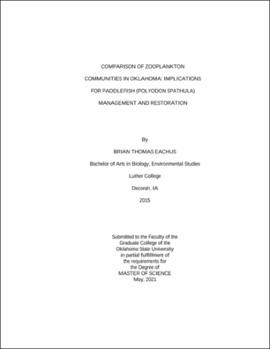| dc.contributor.advisor | Dzialowski, Andrew R. | |
| dc.contributor.author | Eachus, Brian Thomas | |
| dc.date.accessioned | 2021-09-24T13:57:57Z | |
| dc.date.available | 2021-09-24T13:57:57Z | |
| dc.date.issued | 2021-05 | |
| dc.identifier.uri | https://hdl.handle.net/11244/330909 | |
| dc.description.abstract | American paddlefish (Polyodon spathula) are large riverine planktivores whose populations have declined significantly over the last century. These declines are largely due to overharvest from commercial fishing and habitat alterations resulting from dam construction. Oklahoma Department of Wildlife Conservation (ODWC) and U.S. Fish & Wildlife Service have stocked paddlefish in reservoirs throughout the state with varying degrees of success. ODWC is currently evaluating Tenkiller Lake as a future paddlefish restoration site. To assess barriers to successful paddlefish recovery efforts, we evaluated prey (zooplankton) availability in seven reservoirs and their nine major river tributaries across a gradient of paddlefish population status in Oklahoma. We quantified zooplankton abundance, size (carapace length) and community structure, in addition to water quality samples for analysis of total phosphorus (nutrients) and chlorophyll a (primary productivity). Zooplankton were collected from rivers using a plankton pump in spring to coincide with paddlefish spawning activities and early growth of juvenile fish. We collected zooplankton from reservoirs in summer with vertical tows using a Wisconsin plankton net. Rivers flowing into Texoma (failed) and Eufaula (under evaluation) had lower water clarity and generally higher abundance of large zooplankton compared to rivers with naturally reproducing paddlefish populations (self-sustaining). However, in summer, reservoirs that have self-sustaining paddlefish populations had higher abundances of all zooplankton and large zooplankton (copepods and cladocerans) than reservoirs that have failed to establish a reproducing population. Additionally, self-sustaining paddlefish populations tended to occur in reservoirs with a higher proportion of large zooplankton. These reservoirs had higher total phosphorus compared to reservoirs without. More intensive sampling is needed in rivers to assess the effect of variable flow on zooplankton. Considering zooplankton as a lone metric for success, Tenkiller appears unlikely to succeed due to low overall abundance of zooplankton, low proportion of large taxa, and lower overall productivity. However, food availability is not the only metric of success and paddlefish establishment is influenced by spawning habitat, reproduction, and recruitment. Future studies should assess the effect of turbidity on juvenile paddlefish feeding efficiency. Additionally, a bioenergetics modeling approach could be used to understanding paddlefish carrying capacity and more complex species interactions. | |
| dc.format | application/pdf | |
| dc.language | en_US | |
| dc.rights | Copyright is held by the author who has granted the Oklahoma State University Library the non-exclusive right to share this material in its institutional repository. Contact Digital Library Services at lib-dls@okstate.edu or 405-744-9161 for the permission policy on the use, reproduction or distribution of this material. | |
| dc.title | Comparison of zooplankton communities in Oklahoma: Implications for paddlefish (Polyodon spathula) management and restoration | |
| dc.contributor.committeeMember | Long, James M. | |
| dc.contributor.committeeMember | Shoup, Daniel E. | |
| osu.filename | Eachus_okstate_0664M_17189.pdf | |
| osu.accesstype | Open Access | |
| dc.type.genre | Thesis | |
| dc.type.material | Text | |
| dc.subject.keywords | management | |
| dc.subject.keywords | oklahoma | |
| dc.subject.keywords | paddlefish | |
| dc.subject.keywords | reservoirs | |
| dc.subject.keywords | rivers | |
| dc.subject.keywords | zooplankton | |
| thesis.degree.discipline | Integrative Biology | |
| thesis.degree.grantor | Oklahoma State University | |
